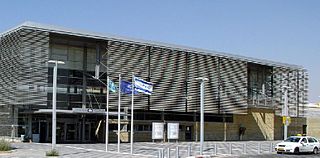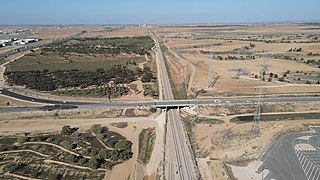Related Research Articles

Transportation in Israel is based mainly on private motor vehicles and bus service and an expanding railway network. A lack of inland waterways and the small size of the country make air and water transport of only minor importance in domestic transportation, but they are vitally important for Israel's international transport links. Demands of population growth, political factors, the Israel Defense Forces, tourism and increased traffic set the pace for all sectors, being a major driver in the mobility transition towards railways and public transit while moving away from motorized road transport. All facets of transportation in Israel are under the supervision of the Ministry of Transport and Road Safety.

Beersheba or Beer Sheva, officially Be'er-Sheva, is the largest city in the Negev desert of southern Israel. Often referred to as the "Capital of the Negev", it is the centre of the fourth-most populous metropolitan area in Israel, the eighth-most populous Israeli city with a population of 211,251, and the second-largest city in the area, with a total area of 117,500 dunams.
Petah Tikva is a city in the Central District of Israel.

Binyamina railway station is an Israel Railways passenger station located in the region of Binyamina-Giv'at Ada and serves these towns, as well as Zikhron Ya'akov, Or Akiva and other small communities in the area.

Hadera Ma'arav (West) railway station is an Israel Railways passenger station and freight terminal located in the city of Hadera. It serves the city, including its large industrial zones, as well as other small communities in the area.

Transport in Jerusalem is characterized by a well-developed inter-city network and an emerging, developing intra-city network. Ben Gurion International Airport serves as Jerusalem's closest international airport. Egged bus lines and Israel Railways connect the city of Jerusalem to much of Israel, and a high-speed rail line to the airport and Tel Aviv is currently under construction, while the segment to Ben Gurion Airport is already in limited operation. Within the city, the roads, rather than the rails, are the primary mode of transportation.

Ramla railway station is a railway station in Ramla, Israel, on the Tel Aviv–Beit Shemesh–Jerusalem line. The station is located in the east of Ramla. The station is also on a section shared with the Be'er Sheva–Tel Aviv line, which branches out in a southerly direction about 3 km east of Ramla.


Be'er Sheva Center railway station is an Israel Railways terminal in Beersheba. It is located on Yitzhak Ben Zvi street next to the city's central bus station and HaNegev Mall. It is one of two railway stations serving the city, the other being Be'er Sheva North, located near the Ben-Gurion University of the Negev.

Rail transport in Israel includes heavy rail as well as light rail. Excluding light rail, the network consists of 1,384 kilometers (860 mi) of track, and is undergoing constant expansion. All of the lines are standard gauge and as of 2023 approximately one-fifth of the heavy rail network is electrified, with additional electrification work underway. A government owned rail company, Israel Railways, manages the entire heavy rail network. Most of the network is located on the densely populated coastal plain.

Rehovot railway station is an Israel Railways station located in the city of Rehovot. It serves the city, the Weizmann Institute of Science and the nearby science industries park, as well as the city of Ness Ziona. The station is named after Ehud Hadar, CEO of Israel Railways between 1994 and 1996.

The Tel Aviv transportation system is seen as the hub of the Israeli transport network in terms of road, rail, and air transport. The Israeli road network partly centers on Tel Aviv, with some of the country's largest highways passing through or running to the city. The city forms a major part of the country's rail network, whilst Ben Gurion International Airport located near the city is the country's largest airport. There is also a strong public transport system within the city, based primarily on bus transportation.

The Railway to Beersheba is a railroad line that runs from central Israel to the Zin Factories in southern Israel, with a spur to the Be'er Sheva Center Railway Station and branch lines to Ramat Hovav, the Arad phosphate mines and factories in Tzefa, and a connection to the Ashkelon–Beersheba railway. It is part of the main line of Israel Railways, of which the northern starting point of the line designated as the "line to Beersheba" is usually indicated as beginning at Na'an junction, where the railway splits to Beersheba and Jerusalem. Because the line is not limited to Beersheba, it is known in Israel as Mesilat HaDarom.

Beersheba metropolitan area is a metropolitan area in Israel that encompasses the Beersheba and Southern Districts of Israel. It is located in the Negev desert and constitutes the fourth largest metropolitan area in the country, with an estimated population of over 377,100.

Holon Junction railway station is a railway station on the Rosh HaAyin–Beersheba line. The station is located at the Holon Interchange which separates Tel Aviv from its southern suburb Holon.

Holon–Wolfson railway station is a railway station in the border of Holon and Jaffa in the south of Tel Aviv-Yafo Municipality, on the Rosh HaAyin–Beersheba line. The station is in the Wolfson interchange on the Ayalon Highway, nearby Wolfson Medical Center.

Bat Yam–Yoseftal railway station is a railway station on the Rosh HaAyin–Beersheba line. It is located at the Yoseftal interchange on the Ayalon Highway, on the border between Bat Yam and Holon, just south of Tel Aviv, Israel.
The High-speed railway to Eilat (Med-Red) is a proposed Israeli railway that will enable the connection of the main Israeli population centers and Mediterranean ports to the southern city of Eilat on the Red Sea coast, as well as serve commercial freight between the Mediterranean Sea and Red Sea (Eilat). The railway will spur southward from the existing rail line at Beersheba, and continue through Dimona to the Arava, Ramon Airport and Eilat, at a speed of 350 kilometers per hour (220 mph). Its length will be roughly 260 km (160 mi) of electrified double-track rail. Currently Dimona railway station is the southernmost passenger train station in Israel and the one with the least boardings/alightings.

The Ashkelon–Beersheba railway is a railway line linking Ashkelon and Beersheba operated by Israel Railways. It spans approximately 60 km of double track in the northern Negev region of southern Israel and provides rail service to the cities of Sderot, Netivot and Ofakim. The line links Beersheba, Sderot, Netivot, and Ofakim to Ashkelon and Tel Aviv.
The Ashkelon Subdistrict is the northern of the two sub-districts in Israel's Southern District. Its population is more than half a million. It is an important region for manufacturing including electricity production and water desalination, agriculture, transportation, tourism, and trade.
References
- ↑ Bocker, Ran (15 July 2012). "From Beersheva to Tel Aviv in 55 Minutes". Ynet (in Hebrew). Retrieved 15 July 2012.